June 16, 2025 | 16:48 GMT +7
June 16, 2025 | 16:48 GMT +7
Hotline: 0913.378.918
June 16, 2025 | 16:48 GMT +7
Hotline: 0913.378.918
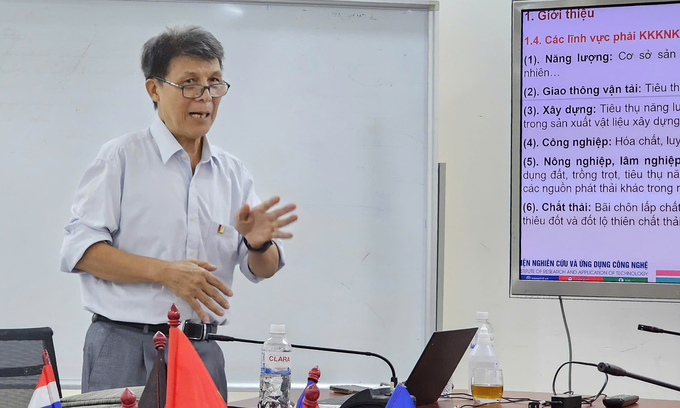
Dr. Le Hai Hung: "Emissions are essentially an energy use process". Photo: Bao Thang.
Greenhouse gases are those that can absorb (retain) and emit energy at wavelengths in the thermal infrared range, causing the greenhouse effect.
Dr. Le Hai Hung, Director of the Institute of Research and Technology Application (IRAT), stated that the largest contributor to the greenhouse effect is water vapor (approximately 50 - 70%), followed by ozone (about 10%). However, these two gases cannot be influenced by humans to reduce the greenhouse effect. "We focus only on reducing CO2, CH4 and N2O", he said.
The lifespan and global warming potential of each gas differs significantly. For CO2, this gas virtually persists indefinitely in the atmosphere, but its heat absorption capacity is much lower than that of CH4 and N2O. The Intergovernmental Panel on Climate Change (IPCC) estimates that if we consider the heat absorption (radiative) capacity of CO2 to be 1, then CH4 is rated at 81 (over 20 years), while N2O is rated at 273 (over 20 years). Notably, SF6 has a coefficient that is 7.430 times greater than that of CO2.
However, the lifespan of CH4, N2O and SF6 is not very long, at 12, 109 and 52 years, respectively. Their heat absorption (radiative) capacity in the atmosphere typically decreases over time. For example, CH4 decreases by more than 60% from 20 to 100 years. The same applies to HFC-21 (CHCl2F) and tetrachloroform (CH3CCl3). In contrast, N2O remains nearly constant, whether measured over 20 years or 100 years.
Due to these characteristics, the world has adopted CO2 as the "standard" unit for measuring greenhouse gases. Other greenhouse gases, such as CH4 and N2O, are converted into equivalent values. According to IPCC guidelines and global databases on emission factors, the global warming potential (GWP) of 1 ton of CH4 is equivalent to 28 tons of CO2e, while 1 ton of N2O is equivalent to 265 tons of CO2e.
For example, the complete combustion of 1 ton of diesel oil (DO) produces approximately 3.186 tons of CO2, along with 0.129 tons of CH4 and 0.03 tons of N2O. When converted, 1 ton of diesel oil emits around 3.197 tons of CO2e, based on the first-tier calculation method for greenhouse gas inventories.
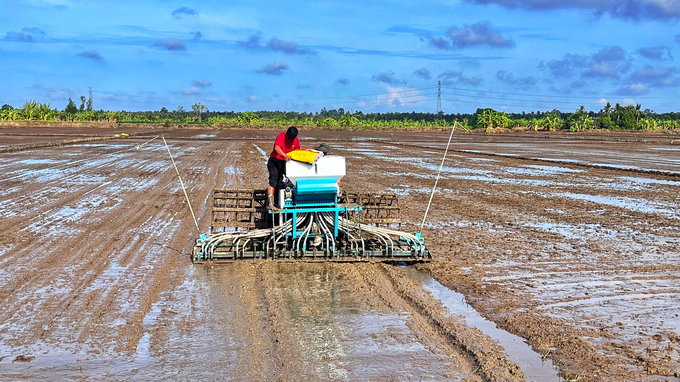
The agriculture sector has developed several low-emission rice field models in the Mekong Delta. Photo: TL.
In reality, greenhouse gases have existed in the atmosphere for a long time, but their concentrations of gases such as CO2, CH4 and N2O only began to rise rapidly when humanity entered the first industrial revolution (around 1750). This rate accelerated further with the onset of the second industrial revolution (in 1870), marked by the invention of electricity.
Alongside studies on greenhouse gases, the phenomenon of the greenhouse effect is also discussed. However, fairly speaking, it is precisely due to this effect that the Earth's average temperature is maintained at around 15 degrees Celsius instead of -20 degrees Celsius, ensuring the survival and development of life.
It wasn't until the emissions of CO2, CH4 and N2O became excessive that the issue became serious, leading to numerous challenges such as ocean acidification, rising sea levels and climate change.
These challenges vary by country. Dr. Le Hai Hung reported that the per capita greenhouse gas emissions in Vietnam and several comparable countries like Indonesia, Thailand and Malaysia in 2022 were 4.882, 4.473, 6.668 and 10.499 tons of CO2, respectively.
When considering GDP scale, each 1.000 USD generated from these economies corresponded to emissions of 1.191, 0.954, 0.875 and 0.797 tons of CO2, respectively. This indicates that while Malaysia has relatively high per capita greenhouse gas emissions, it faces fewer "challenges" compared to the other three countries when looked at from an economic scale.
In their Net Zero commitments at COP 26, three of the four mentioned countries aim for carbon neutrality by 2050, with Indonesia targeting 2060.

Participants attending the training session on greenhouse gas inventory. Photo: Bao Thang.
In 1997, the Kyoto Protocol was adopted. Article 17 laid the foundation for the emissions trading market, where countries with surplus greenhouse gas emission allowances can sell them to nations exceeding their committed quotas. This created a new type of commodity in the form of certificates for reducing or absorbing greenhouse gases.
Since CO2 is the equivalent greenhouse gas for other types of greenhouse gases, these transactions are collectively referred to as carbon trading. The market for trading between countries is also known as the carbon market.
In addition to the credit system, the world employs various other measures to quantify and enhance the transparency of the carbon market. One popular method is the carbon footprint, defined as the total greenhouse gases emitted directly or indirectly into the atmosphere for a specific activity, process or product.
In Vietnam, the Ministry of Agriculture and Rural Development (MARD) has collaborated with localities to successfully implement a carbon footprint program for dragon fruit. From 2021 to 2023, Binh Thuan Province, with guidance from MARD and the United Nations Development Programme (UNDP), has been transitioning to green and clean dragon fruit production. This includes replacing incandescent bulbs with LED lights, promoting water-saving irrigation techniques and utilizing electronic logbooks and QR codes for traceability.
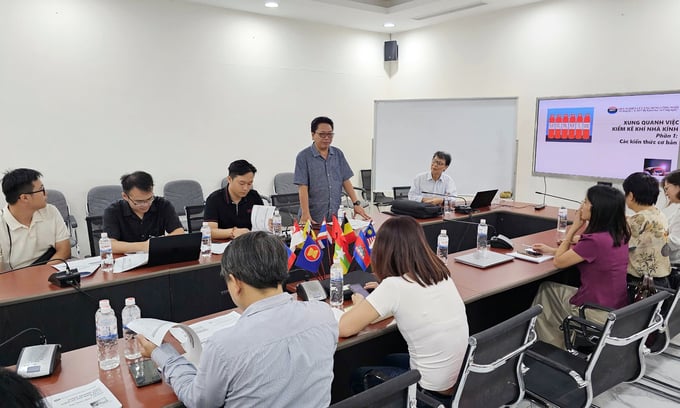
The director of Vitad-Agri hopes that organizations and individuals will gain a deeper understanding of emission reduction. Photo: Bao Thang.
These initial successes open up new opportunities for the goods production sector to penetrate deeper into the global supply chain, even though the carbon footprint concept has been implemented worldwide for a long time. The iPhone is one example. According to Apple, the latest product, the iPhone 16, is produced entirely using renewable energy instead of traditional grid electricity. Measurements show that the carbon footprint of this product has decreased by about 3% compared to its predecessor, the iPhone 15.
Manufacturers are also responsibly disclosing their carbon footprints. On September 20, 2024, when the iPhone 16 was launched globally, Apple announced all carbon footprint information about the product a week earlier, around September 12.
Vietnam still faces certain challenges in its efforts to reduce emissions, both subjectively and objectively. Dr. Le Hai Hung believes that there are still some legal gaps in training, licensing, inventorying, and recognizing activities related to greenhouse gases and emission reductions. Information about the carbon market is also not very complete.
Additionally, the demand and proportion of fossil fuel energy usage in Vietnam remain relatively high compared to the average. For instance, with the same amount of 1.200 USD, producing one iPhone emits about 75 kg of CO2e, whereas converting that amount into 2 tons of steel results in emissions more than 70 times higher.
"Emissions are essentially an energy use process. To reduce emissions, we must decrease fossil fuel sources and increase green energy, enhance reforestation, and implement more technical advancements in rice cultivation, such as the "1 must, 5 reductions" approach or alternate wetting and drying irrigation", said Dr. Hung.
The training session on greenhouse gas inventorying was organized by the Vietnam Institute of Applied Technology and Agricultural Development (Vitad-Agri) in collaboration with the Institute of Research and Applied Technology (IRAT). Vitad-Agri Director Pham Dinh Nam hopes that organizations and individuals interested in greenhouse gases and related issues, such as carbon credits and the carbon market, will gain a more comprehensive and in-depth understanding of these new topics in Vietnam.
Translated by Phuong Linh
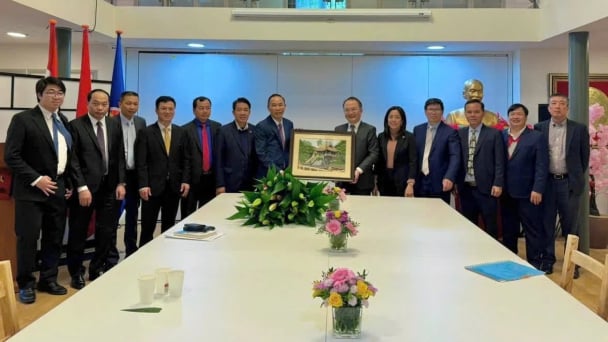
(VAN) The working delegation from the Ministry of Agriculture and Environment conducted an important trip to the Netherlands to strengthen strategic partnerships and sustainable development in the agricultural sector.
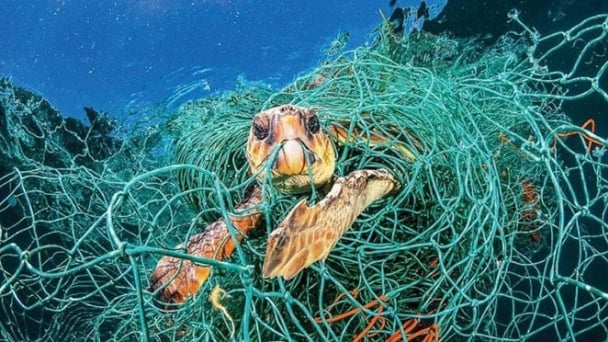
(VAN) The letter ‘A Plea from the Ocean’ not only evokes emotion but also awakens the human conscience to the responsibility of protecting life on Earth.
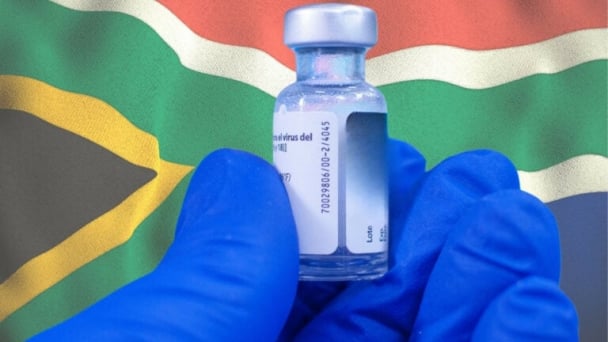
(VAN) The Department of Agriculture in South Africa has announced the country’s first mass vaccination of poultry to prevent local birds from contracting avian influenza.

(VAN) Establishment of the Mekong Delta Regional Agricultural Linkage Center, aiming for a closed value chain, deep processing, trading platforms, and international market connectivity.

(VAN) Gia Lai province has recently recorded 460 rare species of animals and plants, contributing to forest conservation and biodiversity planning in the region.

(VAN) Ms. Caroline Beresford, New Zealand Ambassador to Vietnam, expressed confidence that agricultural cooperation between Vietnam and New Zealand will develop sustainably, be climate-resilient, and promote gender equality.

(VAN) Vietnam reaffirms its commitment to international cooperation in fostering sustainable and responsible fisheries while ensuring resilient livelihoods for small-scale fishing communities.